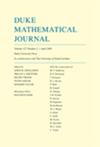非阿基米德积分作为复积分的极限
IF 3
1区 数学
Q1 MATHEMATICS
引用次数: 6
摘要
我们解释了Chambert-Loir和Ducros所考虑的非阿基米德积分是如何在复积分族的渐近性中自然产生的。为了进行这种分析,我们对复数域的非标准模型进行了研究,该模型同时被赋予了阿基米德范数和非阿基米德范数。我们的主要结果表明,在阿基米德形式和非阿基米德形式的双复形之间存在一个与积分相容的自然态射。本文章由计算机程序翻译,如有差异,请以英文原文为准。
Non-Archimedean integrals as limits of complex integrals
We explain how non-archimedean integrals considered by Chambert-Loir and Ducros naturally arise in asymptotics of families of complex integrals. To perform this analysis we work over a non-standard model of the field of complex numbers, which is endowed at the same time with an archimedean and a non-archimedean norm. Our main result states the existence of a natural morphism between bicomplexes of archimedean and non-archimedean forms which is compatible with integration.
求助全文
通过发布文献求助,成功后即可免费获取论文全文。
去求助
来源期刊
CiteScore
3.40
自引率
0.00%
发文量
61
审稿时长
6-12 weeks
期刊介绍:
Information not localized

 求助内容:
求助内容: 应助结果提醒方式:
应助结果提醒方式:


